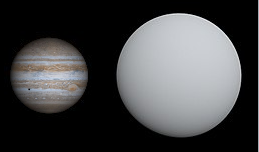The Hungarian Automated Telescope Network (HATNet) project is a network of six small fully automated "HAT" telescopes. The scientific goal of the project is to detect and characterize extrasolar planets using the transit method. This network is used also to find and follow bright variable stars. The network is maintained by the Center for Astrophysics | Harvard & Smithsonian.

CoRoT-3b is a brown dwarf or massive extrasolar planet with a mass 21.66 times that of Jupiter. The object orbits an F-type star in the constellation of Aquila. The orbit is circular and takes 4.2568 days to complete. It was discovered by the French-led CoRoT mission which detected the dimming of the parent star's light as CoRoT-3b passes in front of it.

An exoplanet is a planet located outside the Solar System. The first evidence of an exoplanet was noted as early as 1917, but was not recognized as such until 2016; no planet discovery has yet come from that evidence. What turned out to be the first detection of an exoplanet was published among a list of possible candidates in 1988, though not confirmed until 2003. The first confirmed detection came in 1992, with the discovery of terrestrial-mass planets orbiting the pulsar PSR B1257+12. The first confirmation of an exoplanet orbiting a main-sequence star was made in 1995, when a giant planet was found in a four-day orbit around the nearby star 51 Pegasi. Some exoplanets have been imaged directly by telescopes, but the vast majority have been detected through indirect methods, such as the transit method and the radial-velocity method. As of 1 July 2024, there are 6,660 confirmed exoplanets in 4,868 planetary systems, with 995 systems having more than one planet. This is a list of the most notable discoveries.
CoRoT-13b is a transiting exoplanet found by the CoRoT space telescope on 12 July 2010.

The Next-Generation Transit Survey (NGTS) is a ground-based robotic search for exoplanets. The facility is located at Paranal Observatory in the Atacama desert in northern Chile, about 2 km from ESO's Very Large Telescope and 0.5 km from the VISTA Survey Telescope. Science operations began in early 2015. The astronomical survey is managed by a consortium of seven European universities and other academic institutions from Chile, Germany, Switzerland, and the United Kingdom. Prototypes of the array were tested in 2009 and 2010 on La Palma, and from 2012 to 2014 at Geneva Observatory.
Kepler-432b (also known by its Kepler Object of Interest designation KOI-1299.01) is a hot super-Jupiter (or "warm" super-Jupiter) exoplanet orbiting the giant star Kepler-432 A, the innermost of two such planets discovered by NASA's Kepler spacecraft. It is located about 2,830 light-years (870 parsecs, or nearly 2.684×1016 km) from Earth in the constellation Cygnus. The exoplanet was found by using the transit method, in which the dimming effect that a planet causes as it crosses in front of its star is measured.

HIP 11915 b is an exoplanet orbiting the solar twin star HIP 11915 about 190 light-years (57 parsecs, or nearly 1.798×1015 km) from Earth in the constellation Cetus. It is notable as the first exoplanet to be discovered with an orbit and mass similar to that of Jupiter (essentially, a "Jupiter analog"), suggesting that its system may be similar to that of the Solar System. It orbits its star at a distance of approximately 4.8 AU. The exoplanet was found by using the radial velocity method, where periodic Doppler shifts of spectral lines of the host star suggest an orbiting object.
Kepler-419c is a super-Jupiter exoplanet orbiting within the habitable zone of the star Kepler-419, the outermost of two such planets discovered by NASA's Kepler spacecraft. It is located about 3,400 light-years from Earth in the constellation Cygnus. The exoplanet was found by using the transit timing variation method, in which the variations of transit data from an exoplanet are studied to reveal a more distant companion.

K2-33b is a very young super-Neptune exoplanet, orbiting the pre-main-sequence star K2-33. It was discovered by NASA's Kepler spacecraft on its "Second Light" mission. It is located about 456 light-years away from Earth in the constellation of Scorpius. The exoplanet was found by using the transit method, in which the dimming effect that a planet causes as it crosses in front of its star is measured.
Kepler-419b is a hot Jupiter exoplanet orbiting the star Kepler-419, the outermost of two such planets discovered by NASA's Kepler spacecraft. It is located about 3,400 light-years (1040 parsecs from Earth in the constellation Cygnus.
38 Virginis b is a super-Jupiter exoplanet orbiting within the habitable zone of the star 38 Virginis about 108.5 light-years from Earth in the constellation Virgo. The exoplanet was found by using the radial velocity method, from radial-velocity measurements via observation of Doppler shifts in the spectrum of the planet's parent star.

TRAPPIST-1e, also designated as 2MASS J23062928-0502285 e, is a rocky, close-to-Earth-sized exoplanet orbiting within the habitable zone around the ultracool dwarf star TRAPPIST-1, located 40.7 light-years away from Earth in the constellation of Aquarius. Astronomers used the transit method to find the exoplanet, a method that measures the dimming of a star when a planet crosses in front of it.

NGTS-3Ab is a gas giant exoplanet that orbits a G-type star. Its mass is 2.38 Jupiters, it takes 1.7 days to complete one orbit of its star, and is 0.023 AU from its star. Its discovery was announced in 2018. The Jupiter-like planet is discovered by 39 astronomers, mainly Max Günther, Didier Queloz, Edward Gillen, Laetitia Delrez, and Francois Bouchy.

HATS-36b is a gas giant exoplanet that orbits an F-type star. Its mass is 3.216 Jupiters, it takes 4.2 days to complete one orbit of its star, and is 0.05425 AU from it. It was discovered on June 12, 2017 and was announced in 2018. Its discoverers were 23, namely Daniel Bayliss, Joel Hartman, George Zhou, Gaspar Á. Bakos, Andrew Vanderburg, J. Bento, L. Mancini, S. Ciceri, Rafael Brahm, Andres Jordán, N. Espinoza, M. Rabus, T. G. Tan, K. Penev, W. Bhatti, M. de Val-Borro, V. Suc, Z. Csubry, Th. Henning, P. Sarkis, J. Lázár, I. Papp, P. Sári.
CoRoT-21b is a transiting exoplanet reportedly found by the CoRoT space telescope in 2011. Planetary parameters were published in 2012.
NGTS-1, also designated as TOI-551 is a solitary star located in the southern constellation Columba, the dove. With an apparent magnitude of 15.52, NGTS-1 can only be seen through a powerful telescope. Gaia DR3 parallax measurements imply a distance of 710 light-years and it is drifting away rapidly with a heliocentric radial velocity of 97.2 km/s.
Kepler-93b (KOI-69b) is a hot, dense transiting Super-Earth exoplanet located approximately 313 light-years away in the constellation of Lyra, orbiting the G-type star Kepler-93. Its discovery was announced in February 2014 by American astronomer Geoffrey Marcy and his team. In July 2014, its radius was determined with a mere 1.3% margin of error, the most precise measurement ever made for an exoplanet's radius at the time.
NGTS-13b is an exoplanet that was discovered by NGTS. It takes 4.12 days to orbit its host star and its discovery was announced in January 2021.











